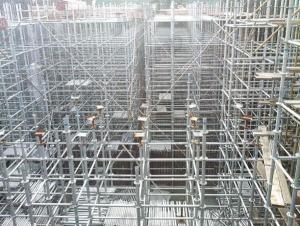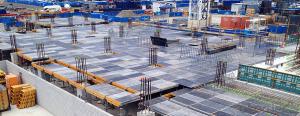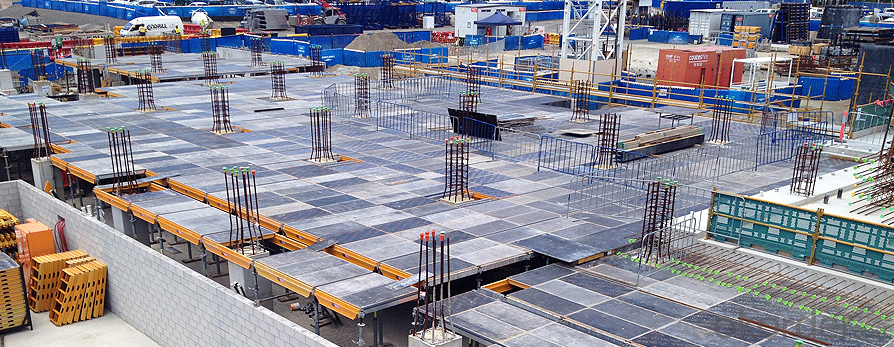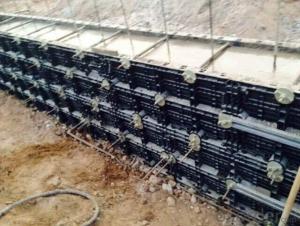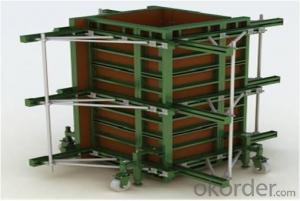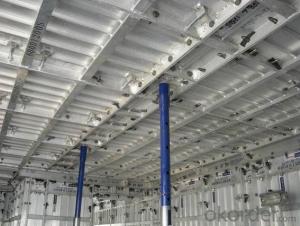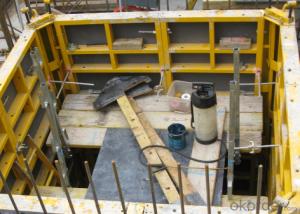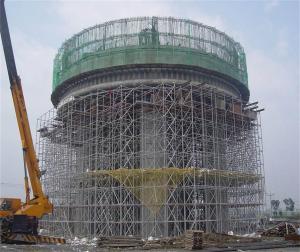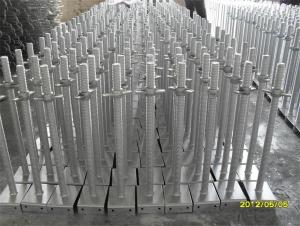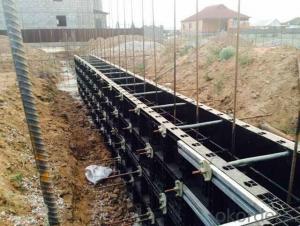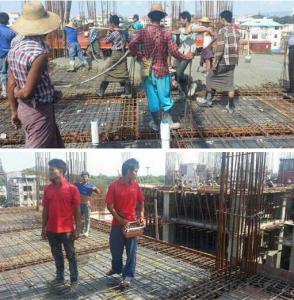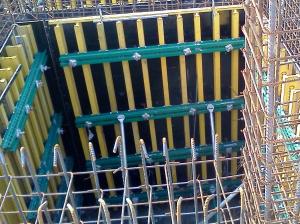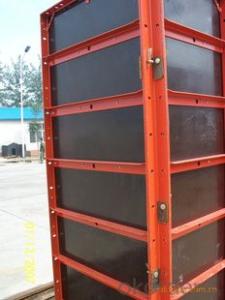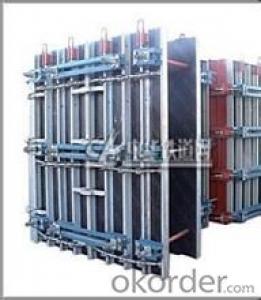The Advantaged Plastic Formworks in CNBM
- Loading Port:
- Tianjin
- Payment Terms:
- TT OR LC
- Min Order Qty:
- 1000 set
- Supply Capability:
- 50000 set/month
OKorder Service Pledge
OKorder Financial Service
You Might Also Like
Specification
Plastic Formwork Concrete Formwork Parts Of A Tubular Scaffolding Low Price
Developing with new technology materials, steel formworks is no longer a must in construction concrete process. More and more buildings are established with plastic formworks. And workers love this new formworks much more.

The advantages of plastic formworks:
1.First of all--light
Yes it is the first advantage of plastic formwork. It wins the great praise of both contractors and workers.
The biggest panel is 120×1500px,weights 10.5kg only. It can be lift and set up by one person easily, which means there is no need for cranes on site.Saves a lot of cost and time.
2.Easy set up
Different size of panels can firmly locked by simply turn the special handles to 90 degree. The Panels has rib on the back, which makes the system need not traditional wood blocks and nails. The panels have holes to fit tie rod, guarantee the strength of the whole system.
3.Modularity
Modular formworks composed by different size of panels,the main item is 120×1500px panel,which is used for the large area of walls and slabs. There are also small size of panels of multiply by 125px. The material of modular formwork is PC-ABS mixed with special glass fibers which enable panels to hold high pressures.
4.Strength
The handles are made by high strength Nilon, each panel locked by at least 4 handles, which makes the whole system strong enough to pour 1000px walls.
FAQ
We have organized several common questions for our clients, may help you sincerely:
1)How is the Packaging Details?
In bags or as the requirement ofcustomers.
2)How long can we receive the product after purchase?
Lead time is about 30days after getting the signed PI and deposit.
- Q: PKPM how to add lateral restraint steel frame
- As for the landlord said lateral constraints, generally refers to the vertical component, that is to increase the size of the vertical component size. Or express clearly in question.If you help, please accept, thank you!
- Q: How does steel frame formwork help in achieving accurate dimensions?
- Steel frame formwork helps in achieving accurate dimensions by providing a rigid and stable structure that ensures precise alignment and positioning of the concrete elements. The steel frames act as a guide and support system, allowing for consistent and uniform pouring of the concrete. Additionally, the inherent strength of steel minimizes any flexing or movement during the pouring and curing process, resulting in accurately measured and dimensioned concrete structures.
- Q: How does steel frame formwork handle the placement of external cladding and façade materials within the concrete structure?
- Steel frame formwork provides a strong and stable framework for the placement of external cladding and façade materials within the concrete structure. The steel frame acts as a support system, allowing for precise and accurate installation of cladding materials. It ensures that the cladding is securely attached to the concrete structure, offering durability and resistance to external forces such as wind and weather conditions. Additionally, the steel frame formwork facilitates efficient and streamlined construction processes, enabling the timely completion of the project.
- Q: What are the transportation and logistics considerations for steel frame formwork?
- Transportation and logistics considerations for steel frame formwork include the weight and size of the frames, the availability of appropriate transportation vehicles, the need for proper handling and securing during transit to prevent damage, and the coordination and planning of delivery routes and schedules to ensure timely and efficient delivery to construction sites.
- Q: Can steel frame formwork be used for tall structures?
- Yes, steel frame formwork can be used for tall structures. Steel frame formwork is known for its strength and durability, making it suitable for constructing tall buildings. Its rigid structure allows for precise and efficient concrete pouring, ensuring the stability and integrity of the structure. Additionally, steel frame formwork can be easily adjusted and reused, making it a cost-effective solution for tall construction projects.
- Q: Are there any environmental benefits to using steel frame formwork?
- Using steel frame formwork in construction projects brings several environmental benefits. Firstly, steel is a highly durable material that maintains its structural integrity even after multiple uses. This means that steel formwork can be employed for various construction projects, reducing the need for new formwork materials and minimizing waste generation. Moreover, steel frame formwork can be easily dismantled and reassembled, making it adaptable and versatile for different construction needs. Additionally, steel is a recyclable material, meaning that it can be recycled and transformed into new steel products at the end of its life cycle. This helps reduce the demand for new steel production and the associated environmental impacts, such as mining and energy consumption. Furthermore, steel frame formwork contributes to energy efficiency in construction. Its superior strength and load-bearing capacity allow for the construction of more slender and lightweight structures. As a result, less material is used overall, leading to energy savings during manufacturing, transportation, and installation processes. In conclusion, opting for steel frame formwork offers a range of environmental benefits, including durability, reusability, recyclability, and energy efficiency. By choosing this construction method, projects can minimize waste generation, conserve resources, and reduce their environmental footprint.
- Q: How does steel frame formwork ensure proper ventilation during concrete curing?
- Proper ventilation during concrete curing cannot be directly ensured by steel frame formwork. Nevertheless, it can indirectly aid ventilation by allowing ample space between the formwork panels and the concrete surface. This space permits air circulation and facilitates the evaporation of excess moisture during the curing process. Furthermore, steel frame formwork may include strategically positioned holes or slots to amplify airflow and foster appropriate ventilation. However, it is crucial to acknowledge that the primary responsibility for guaranteeing proper ventilation during concrete curing rests with the overall construction design, which encompasses the implementation of appropriate curing techniques and the provision of sufficient ventilation openings in the formwork system.
- Q: What are the different types of alignment devices used with steel frame formwork?
- Steel frame formwork commonly utilizes various alignment devices to guarantee proper alignment and stability during the concrete pouring process. 1. To provide stability, adjustable props are employed as vertical support devices. These props, typically made of steel, can be adjusted to the desired height and are commonly utilized for supporting the formwork's horizontal beams and panels. 2. Tie rods, which are lengthy steel rods, are utilized to secure the formwork panels together. These rods are inserted through holes in the panels and tightened using nuts to prevent any movement or displacement during concrete pouring. 3. Wedges and clamps are utilized to firmly secure the formwork panels and beams. Wedges are inserted between the panels and tightened with clamps to ensure proper alignment and prevent shifting or movement during the concrete pouring process. 4. Connecting pins, made of metal, are utilized to connect the formwork panels together. These pins are inserted into pre-drilled holes in the panels and secured with locking devices to ensure proper alignment and stability. 5. Bracing systems, consisting of diagonal braces and horizontal beams, provide additional support and stability to larger formwork structures. These systems are employed to prevent deformation or collapse during the concrete pouring process. In summary, these alignment devices play a critical role in ensuring the stability and proper alignment of steel frame formwork. They contribute to the creation of a robust and secure structure capable of withstanding the pressure and weight of the concrete.
- Q: How does steel frame formwork contribute to better dimensional accuracy in precast elements?
- Steel frame formwork contributes to better dimensional accuracy in precast elements by providing a strong and rigid structure that ensures precise and consistent shaping of the concrete. Firstly, the steel frame formwork is designed and manufactured to meet specific dimensional requirements. This ensures that the formwork itself is accurate and allows for the creation of precise precast elements. The steel material is known for its durability and stability, which prevents any deformation or movement during the concrete pouring process. This stability is crucial for maintaining the correct dimensions of the precast elements. Secondly, the steel frame formwork provides a smooth and even surface for the concrete to be poured into. This reduces the likelihood of any irregularities or inconsistencies in the final product. The steel formwork also allows for easy and precise adjustment of the formwork components, ensuring that the dimensions are maintained throughout the construction process. Furthermore, the steel frame formwork can be reused multiple times, making it a cost-effective solution for achieving dimensional accuracy in precast elements. The ability to reuse the formwork means that the same accurate dimensions can be achieved consistently over multiple projects, without the need for constantly creating new formwork. Overall, the use of steel frame formwork in precast element construction significantly contributes to better dimensional accuracy. Its strength, stability, and reusability ensure that the formwork itself is accurate, and the smooth surface it provides allows for precise shaping of the concrete. By using steel frame formwork, precast elements can be manufactured with consistent dimensions, resulting in high-quality and reliable structures.
- Q: What are the different components of a steel frame formwork system?
- A steel frame formwork system consists of several components that work together to provide support and structure during concrete construction processes. These components include: 1. Steel frames: The primary component of a steel frame formwork system is the steel frame itself. These frames are typically made of high-quality steel and are designed to be strong, durable, and able to withstand the weight and pressure exerted by the concrete. 2. Panels: Steel frame formwork systems also include panels that are attached to the steel frames. These panels are typically made of plywood or metal and provide a smooth surface for the concrete to be poured onto. The panels are easy to install, remove, and replace, making them highly efficient and cost-effective. 3. Wedges and clamps: Wedges and clamps are used to secure the panels to the steel frames. Wedges are inserted between the panel and the frame to hold them in place, while clamps provide additional support and stability. These components ensure that the formwork system remains secure and tight during the pouring and curing of the concrete. 4. Adjustable props and supports: To provide additional support and stability, adjustable props and supports are used in a steel frame formwork system. These props and supports are easily adjustable and can be set at different heights to accommodate the desired formwork dimensions. 5. Accessories: Various accessories are also included in a steel frame formwork system, such as corner brackets, alignment clamps, connectors, and anchor bolts. These accessories help to ensure the proper alignment and connection of the formwork components, resulting in a robust and reliable system. Overall, a steel frame formwork system is a versatile and efficient solution for concrete construction projects. Its various components work together to provide a strong and reliable support structure, allowing for the precise pouring and shaping of concrete to create desired structures.
Send your message to us
The Advantaged Plastic Formworks in CNBM
- Loading Port:
- Tianjin
- Payment Terms:
- TT OR LC
- Min Order Qty:
- 1000 set
- Supply Capability:
- 50000 set/month
OKorder Service Pledge
OKorder Financial Service
Similar products
Hot products
Hot Searches
